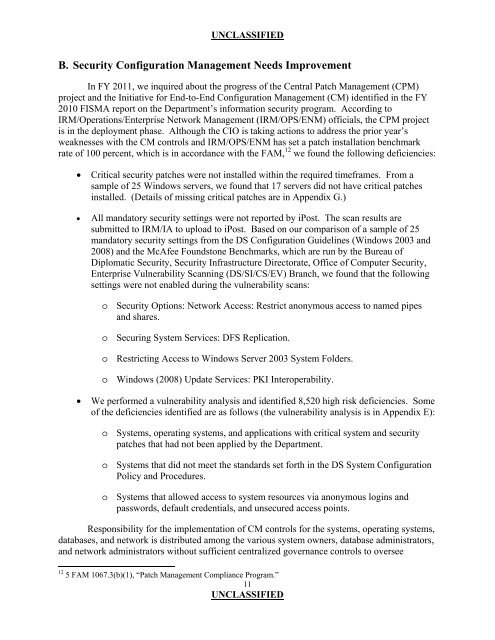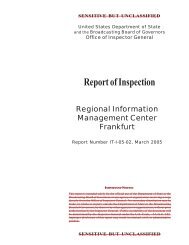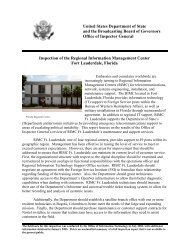Evaluation of Department of State Information Security Program ...
Evaluation of Department of State Information Security Program ...
Evaluation of Department of State Information Security Program ...
Create successful ePaper yourself
Turn your PDF publications into a flip-book with our unique Google optimized e-Paper software.
UNCLASSIFIED<br />
B. <strong>Security</strong> Configuration Management Needs Improvement<br />
In FY 2011, we inquired about the progress <strong>of</strong> the Central Patch Management (CPM)<br />
project and the Initiative for End-to-End Configuration Management (CM) identified in the FY<br />
2010 FISMA report on the <strong>Department</strong>’s information security program. According to<br />
IRM/Operations/Enterprise Network Management (IRM/OPS/ENM) <strong>of</strong>ficials, the CPM project<br />
is in the deployment phase. Although the CIO is taking actions to address the prior year’s<br />
weaknesses with the CM controls and IRM/OPS/ENM has set a patch installation benchmark<br />
rate <strong>of</strong> 100 percent, which is in accordance with the FAM, 12 we found the following deficiencies:<br />
� Critical security patches were not installed within the required timeframes. From a<br />
sample <strong>of</strong> 25 Windows servers, we found that 17 servers did not have critical patches<br />
installed. (Details <strong>of</strong> missing critical patches are in Appendix G.)<br />
� All mandatory security settings were not reported by iPost. The scan results are<br />
submitted to IRM/IA to upload to iPost. Based on our comparison <strong>of</strong> a sample <strong>of</strong> 25<br />
mandatory security settings from the DS Configuration Guidelines (Windows 2003 and<br />
2008) and the McAfee Foundstone Benchmarks, which are run by the Bureau <strong>of</strong><br />
Diplomatic <strong>Security</strong>, <strong>Security</strong> Infrastructure Directorate, Office <strong>of</strong> Computer <strong>Security</strong>,<br />
Enterprise Vulnerability Scanning (DS/SI/CS/EV) Branch, we found that the following<br />
settings were not enabled during the vulnerability scans:<br />
o <strong>Security</strong> Options: Network Access: Restrict anonymous access to named pipes<br />
and shares.<br />
o Securing System Services: DFS Replication.<br />
o Restricting Access to Windows Server 2003 System Folders.<br />
o Windows (2008) Update Services: PKI Interoperability.<br />
� We performed a vulnerability analysis and identified 8,520 high risk deficiencies. Some<br />
<strong>of</strong> the deficiencies identified are as follows (the vulnerability analysis is in Appendix E):<br />
o Systems, operating systems, and applications with critical system and security<br />
patches that had not been applied by the <strong>Department</strong>.<br />
o Systems that did not meet the standards set forth in the DS System Configuration<br />
Policy and Procedures.<br />
o Systems that allowed access to system resources via anonymous logins and<br />
passwords, default credentials, and unsecured access points.<br />
Responsibility for the implementation <strong>of</strong> CM controls for the systems, operating systems,<br />
databases, and network is distributed among the various system owners, database administrators,<br />
and network administrators without sufficient centralized governance controls to oversee<br />
12<br />
5 FAM 1067.3(b)(1), “Patch Management Compliance <strong>Program</strong>.”<br />
11<br />
UNCLASSIFIED








